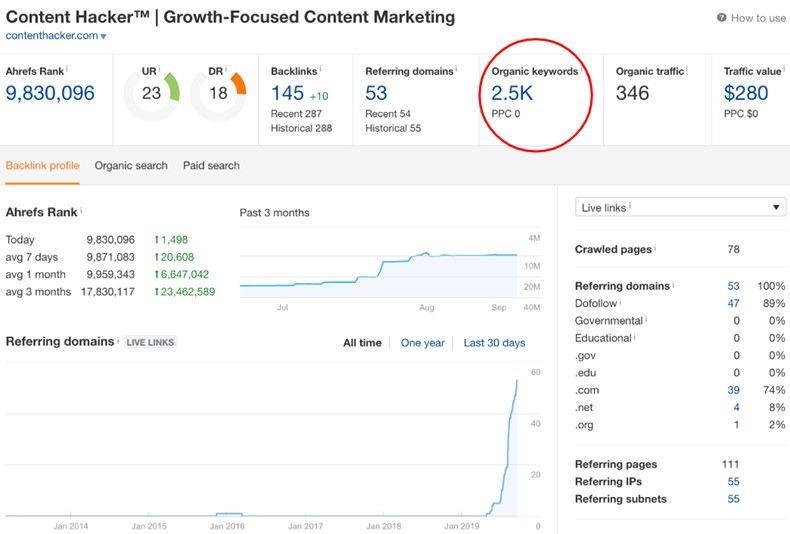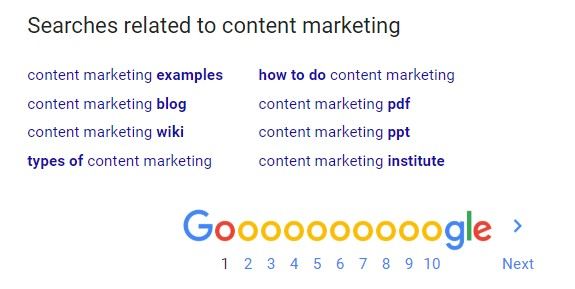Creating content that ranks involves both art and science.
The creativity, writing voice, and style you use make up the art side. Finessing language and clearly conveying information engages readers, which helps your SEO.
Meanwhile, the science side involves implementing a repeatable formula, which is the key to creating useful content that's topically relevant to your focus keyword.
Combine the two, the art and science of content, and you'll delight readers as well as search engines—a powerful combination that equals ranking on Page One of search engine results pages (SERPs).
Marketers covet a Page One ranking on Google for a reason: 54% of the clicks for an average SERP go to positions 1, 2, and 3. Since 71% of all website traffic traces back to Google searches, those spots are chock-full of possibility for traffic, leads, and conversions.
We have seen that opportunity play out with our own content marketing at my company, perfecting a recipe for ranking through eight years of blogging. Once we started focusing on strategic, structured content and consistency—we have never missed our goal of one blog post per week—our ROI has gone through the roof:
- Ranking for nearly 24,000 keywords
- 90,000 in organic traffic per month
- $4.5 million in sales from over 5,000 clients

More recently, we implemented the same strategy for ranking on a brand-new site called Content Hacker. Here's how that's working.
How Structured, Long-Form Content Wins Rankings
Similar to what we did on Express Writers, on Content Hacker we focused on publishing the most comprehensive, structured blog guides targeting focus keywords we could rank for in Google.

The average word count for our fewer than 15 blog posts is 4,500. The longest is 5,000 words.
The result? We nailed 2,500+ organic keyword rankings, bringing in nearly 400 ideal visitors, less than three months after launch.

How, with so few blog posts published?
The answer lies in the combined art and science of ranking content. Hint: It's both strategically structured and long-form.
Here's the lowdown.
How to Structure Content: Four Foundational Factors
Time for the good stuff. This is the strategy we use for both Express Writers and Content Hacker.
Make sure you have these four foundational factors nailed down to win in rankings.
1. Before you create anything, commit to being useful
The foundational trait for content that ranks and earns real positions in Google is usefulness.
And, no, it doesn't have to be useful for everyone. In fact, just the opposite.
Your content should be useful for at least one niche audience. It should give them something they didn't have before: knowledge, information, guidance, answers, or even just a new idea or spark of inspiration.
If your content is useless—if it's just you bragging, or if it provides irrelevant information, or it is stuffed with fluff—no one is going to care. No one is going to click your link in a SERP and go, "Yes! This is exactly what I needed!"
Google is wise to that. Google will not prioritize content that fails to fulfill a user's search needs.
Google's E-A-T and YMYL standards speak to the usefulness factor and how much it matters. These show up in the search engine's Search Quality Evaluator Guidelines, which deeply hint at what constitutes a high-quality, rank-worthy page.


- Content should be useful (it should benefit a user in some way and serve some purpose).
- It should be accurate, relevant, and/or helpful, especially if the stakes are high.
After you commit to being useful in every part of writing and creating, you can move on to the other pieces of strategic, researched, structured content.
2. Research topical niche keywords
Keyword research is the place from which content that's appropriately structured truly germinates and grows.
Don't just pick a random keyword and try to rank for it. Instead, choose keywords that resonate with your audience's searches, their needs, and their questions.
Even if the search volume is low, one ideal prospect visiting your site because of a super-relevant, targeted keyword is better than 100 non-prospects from a less relevant but higher-volume term.
- Look at your industry, your expert knowledge, and where they collide. Find keywords that live in that intersection.
- Further drill down your keyword list by using resources like social media, Quora, and Answer the Public to figure out the actual language your audience is using in keywords.
- Use keyword research tools to find out if you can actually rank for your chosen terms, or whether the competition is too steep (new websites need to pay more attention to this than older, established ones). I like KWFinder and SEMrush.
3. Build and vet a blog topic
With a keyword list in hand, you can then move on to build and vet a blog topic your readers will actually want to read.
- Start with a focus keyword from your researched list.
- Build your topic around that keyword.
- Use Google and keyword research tools to discover related keywords you can use in the same piece of content.
- Related keywords may additionally help fill in your content outline.
And to find a quick list of related keywords in Google...
- Type your focus keyword into search.
- Look under "Searches related to…" for a list of terms related to your focus keyword. You can sprinkle these into your content piece!

- Vet your blog topic. Use tools like BuzzSumo to find out what topics are trending or getting the most engagement for your focus keyword.
- Finally, find a fresh angle on the topic using your unique perspective and expertise.
4. Use a long-form structure
The final piece of structured content is the long-form formula. You must...
- Be the best resource on your chosen topic. Whatever you do, to rank well (I'm talking No. 1, here), you need to beat the other blogs ranking for your keyword. That means doing MORE.
More information, deeper research, more current stats, better writing, better formatting, and better use of visuals.
To be better, you literally have to do better.
- Be comprehensive. The most comprehensive blogs cover a topic inside-out. No holes, no leftover questions, no unsatisfying conclusions.
My best tip for hitting the right note with comprehensiveness? Creating an outline.
- Use lots of data and current stats. Research is a key element in ranking content. Whether you conduct your own studies or pull from other sources, you need to make sure the data and stats you use are both credible and current.
For that matter, don't just spout numbers. Back them up. Link to studies, research, collected data, and other experts. Cite them and use their findings to strengthen your own position in your content.
- Include subheaders for readability. Subheaders are essential in long-form content. They break up the text into readable chunks; organize the information under scannable headings; and provide ideal places to add keywords for SEO.
Look at the following Smartblogger piece for inspiration on all of the above: subheaders, comprehensiveness, etc. It's 3,000+ words and is ranking well for a niche keyword.

The article blends the art and science of ranking effortlessly (no wonder: Jon Morrow wrote it).
- The writing is engaging, creative, and clear.
- It has clear takeaways and great visuals.
- It has no fewer than 14 subheads.
- It relies on data and studies to back up claims and points.
- It contains practical advice and actively guides the target reader.
That is exactly how structured content should look. Period.
Ready to Rank? Invest in the Art and Science of Structured, Strategic Content
If ranking in Google is both an art and a science... then that explains why taking random shots in the dark, guessing about keywords, and doing zero research gets you nowhere.
You have to be strategic. You need a formula to create content that ranks, one that blends the creativity and finesse of writing with the logic, structure, and rules of SEO.
To climb the Google mountain, you need both disciplines.




